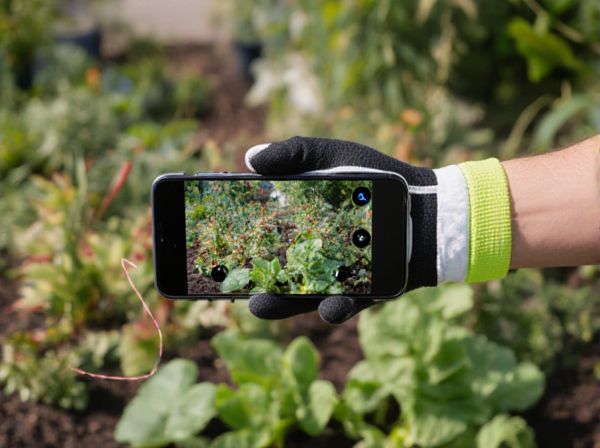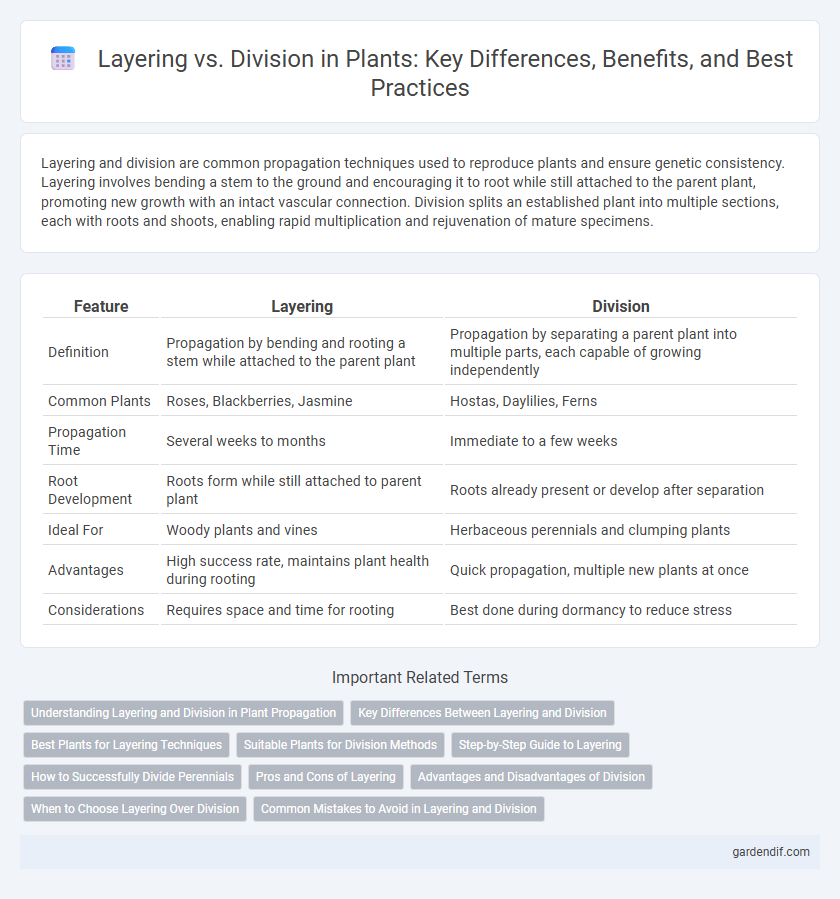
Layering vs Division Illustration
Layering and division are common propagation techniques used to reproduce plants and ensure genetic consistency. Layering involves bending a stem to the ground and encouraging it to root while still attached to the parent plant, promoting new growth with an intact vascular connection. Division splits an established plant into multiple sections, each with roots and shoots, enabling rapid multiplication and rejuvenation of mature specimens.
Table of Comparison
| Feature | Layering | Division |
|---|---|---|
| Definition | Propagation by bending and rooting a stem while attached to the parent plant | Propagation by separating a parent plant into multiple parts, each capable of growing independently |
| Common Plants | Roses, Blackberries, Jasmine | Hostas, Daylilies, Ferns |
| Propagation Time | Several weeks to months | Immediate to a few weeks |
| Root Development | Roots form while still attached to parent plant | Roots already present or develop after separation |
| Ideal For | Woody plants and vines | Herbaceous perennials and clumping plants |
| Advantages | High success rate, maintains plant health during rooting | Quick propagation, multiple new plants at once |
| Considerations | Requires space and time for rooting | Best done during dormancy to reduce stress |
Understanding Layering and Division in Plant Propagation
Layering and division are effective plant propagation methods that promote growth by creating new plants from existing ones. Layering involves encouraging roots to form on a stem while it is still attached to the parent plant, commonly used for shrubs and vines, enhancing root development and increasing survival rates. Division separates a mature plant into multiple parts, each with roots and shoots, ideal for perennials and clumping plants to rejuvenate and expand plant populations efficiently.
Key Differences Between Layering and Division
Layering involves encouraging roots to form on a stem while it is still attached to the parent plant, resulting in a new plant that remains physically connected until established. Division entails separating mature plants into multiple sections, each with roots and shoots, to create independent plants immediately upon separation. Key differences include layering's gradual root development on a living stem versus division's immediate creation of separate plants from existing root systems.
Best Plants for Layering Techniques
Layering techniques thrive with plants like raspberries, hydrangeas, and blackberries due to their flexible stems and vigorous growth. These species root easily when branches touch the soil, ensuring successful propagation and sturdy new plants. Gardeners often prefer these choices for layering because they combine high survival rates with minimal maintenance demands.
Suitable Plants for Division Methods
Suitable plants for division methods include perennials such as hostas, daylilies, and irises, which develop clumps or rhizomes that separate easily. Division is also effective for plants like ferns and ornamental grasses, which regenerate efficiently from root segments. This propagation technique promotes healthy growth and rejuvenation in mature, overcrowded plants.
Step-by-Step Guide to Layering
Layering involves bending a low-growing stem to the ground and covering it with soil to encourage root development while still attached to the parent plant, making it a perfect method for plants like strawberries, blackberries, and honeysuckle. Begin by selecting a healthy, flexible stem, gently wound or remove some bark to expose the inner tissue, then secure it in a shallow trench with soil and keep the area moist to promote new root growth over several weeks. Once roots have formed, sever the new plant from the parent and transplant it, ensuring a higher success rate in propagation compared to division, which requires separating established plant clumps at the root.
How to Successfully Divide Perennials
To successfully divide perennials, begin by carefully digging up the plant to avoid damaging the roots and use a sharp spade or garden fork to separate the clumps into smaller sections with healthy shoots and roots. Ensure each division has at least one growth bud and adequate root mass to support new growth, then immediately replant in well-prepared soil at the same depth as the original plant. Dividing perennials in early spring or fall enhances root establishment and minimizes transplant shock, critical for vigorous recovery and sustained blooming.
Pros and Cons of Layering
Layering promotes root development while the branch is still attached to the parent plant, increasing survival rates and producing a genetically identical new plant. This method requires less specialized equipment and is ideal for propagation of difficult-to-root species but takes longer to produce mature plants compared to division. However, layering may not be suitable for plants with woody stems or limited branch flexibility, limiting its use in some horticultural situations.
Advantages and Disadvantages of Division
Division allows for the propagation of mature plants by separating root clumps, ensuring genetic consistency and faster establishment compared to layering. This method is advantageous for increasing stock quickly and rejuvenating older plants, but it can cause stress or damage to the parent plant and requires careful timing to avoid growth disruption. Unlike layering, division may not be suitable for all species and often demands more labor-intensive handling during the splitting process.
When to Choose Layering Over Division
Choose layering over division when propagating plants that root easily from stems, such as raspberries and magnolias, to ensure higher success rates and maintain genetic consistency. Layering is ideal for encouraging root development while the stem is still attached to the parent plant, reducing transplant shock and enhancing survival. Division suits mature clump-forming perennials better, but layering excels with shrubs and vines requiring gradual establishment.
Common Mistakes to Avoid in Layering and Division
Common mistakes in layering include choosing unhealthy stems, insufficient wounding to encourage rooting, and improperly maintaining humidity levels, leading to poor root development or stem rot. In division, major errors involve dividing plants during dormancy without adequate preparation and using blunt tools that damage root systems, reducing the chances of successful transplantation. Ensuring clean cuts, selecting vigorous shoots, and maintaining optimal moisture are critical for improving propagation outcomes in both methods.
Layering vs Division Infographic

 gardendif.com
gardendif.com